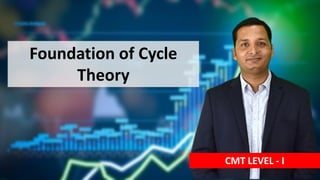
Section 3 - Chapter 19 - Foundation of Cycle Theory.pdf
- 1. Foundation of Cycle Theory CMT LEVEL - I
- 2. Learning Objectives Types of Cycle Characteristic of a Cycle Hurst principles of Commonality Composite waves Left & Right Translation Dominant Cycle Tools for Cycle Identification CMT LEVEL - I
- 3. Basics of Cycle Theory • A cycle is an event, such as a price high or low, which repeats itself on a regular basis. • Cycles exist in the economy, in nature and in financial markets. •Cycle theory asserts that cyclical forces, both long and short, drive price movements in the financial markets. • Cycle have two broad classes: - Fixed Cycles – Linear Cycles - Non Fixed Cycles – Non Linear Cycles
- 4. Cycle Characteristics Cycles bottoms are known as Troughs & tops referred as Crests. •Cycle or wave. A recurring process that returns to its original state. •Amplitude (a). The height of the wave from its horizontal midpoint (the x-axis). •Period (T). The number of time units necessary to complete one wavelength (cycle). •Frequency (ω). The number of wavelengths that repeat every 360°, calculated as ω = 1/T. •Phase. A measurement of the starting point or offset of the cycle relative to a benchmark wave. •Phase angle. Locates the position within the cycle measured as the minute hand of a clock moving clockwise, where 0 ° is three o'clock. •Left and right translation. The tendency for a cycle peak to fall to the left or right of the center of the cycle.
- 6. Principles of Cycle Theory Commonality Cyclicality Harmoncity Summation Synchronicity Proportionality Nominality Variation
- 7. Principles of Cycle Theory • The Principle of Commonality – All equity (or forex or commodity) price movements have many elements in common (in other words similar classes of tradable instruments have price movements with much in common) • The Principle of Cyclicality – Price movements consist of a combination of specific waves and therefore exhibit cyclic characteristics. • The Principle of Summation – Price waves which combine to produce the price movement do so by a process of simple addition. • The Principle of Harmoncity – The wavelengths of neighbouring waves in the collection of cycles contributing to price movement are related by a small integer value.
- 8. Cycle Characteristics • The Principle of Synchronicity – Waves in price movement are phased so as to cause simultaneous troughs wherever possible • The Principle of Proportionality – Waves in price movement have an amplitude that is proportional to their wavelength. •The Principle of Nominality – A specific, nominal collection of harmonically related waves is common to all price movements. •The Principle of Variation – The previous four principles represent strong tendencies, from which variation is to be expected.
- 10. Spectrograms • When working with financial instruments, some cycles fit better than others. • It is possible to collect all these cycles and compare how they fit the data. •This is represented by a graph that shows the length of the cycle versus how well it fits the financial instrument. • A graph like this is called a spectrogram. • A sample of a spectrogram created by Timing Solution is shown below:
- 11. Spectrograms • This spectrogram is also called a periodogram. • The X axis on this diagram corresponds to the period of the cycle, while Y is the strength of this cycle (more exactly, spectrum density). • The highest peaks on this chart indicate cycles that are the strongest in this financial data (in other words, they fit the data we have the best way). • The spectrogram simplifies our life: when we have it, our task is only picking up these top cycles and asking the program to make a projection line from them.
- 12. Wavelet Diagram • Research shows that it is not so important how many cycles you have found in the financial data (like as 55 or 100, or 200 trading days cycle), • Now its important to find the strongest cycle NOW - the dominant cycle . • Therefore, the most important issue is to reveal the appearance of the new dominant cycle/cycles as early as possible. This is why this module has been designed.
- 13. Wavelet Diagram • Research shows that presence of bright zones in the wavelet diagram can be caused by random oscillations of the price. • The bright yellow zones correspond to the periods when some cycle is active.
- 14. Fisher Transform • The Fisher Transform is a technical indicator created by J.F. Ehlers. • The indicator highlights when prices have moved to an extreme, based on recent prices. •This may help in spotting turning points in the price of an asset. • It also helps show the trend and isolate the price waves within a trend.
- 15. Fisher Transform • The Fisher Transform attempts to normalize asset prices, thus making turning points in price clearer. • Some traders look for extreme readings to signal potential price reversal areas, while others watch for a change in direction of the Fisher Transform. • The Fisher Transform formula is typically applied to price, but it can also be applied to other indicators. •Asset prices are not normally distributed, so attempts to normalize prices via an indicator may not always provide reliable signals.
- 16. Fisher Transform
